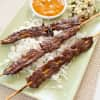Why Charcoal Browns Best
We love the convenience of gas grills, but only the most powerful models can produce the same dark, crusty exterior on food as charcoal. Here’s why.
We love the convenience of gas grills, but only the most powerful models can produce the same dark, crusty exterior on food as charcoal. Here’s why: Grilled foods brown quickly through intense radiant heat produced by the frenetic motion of charged particles in the air around the food. Charcoal, once it has burned down to glowing coals and ash, emits almost all radiant heat. Gas, on the other hand, though it burns about 75 percent hotter than charcoal, gives off very little radiant heat. To compensate, manufacturers insert ceramic rods, metal bars, or lava rocks above the flames of gas grills to capture the energy from the burning fuel and convert it into radiant heat. But as the hot gases travel from the flames to these radiant surfaces, some are simply carried away by air currents. This makes it difficult to raise the temperature of the radiant emitters as high as that of glowing coals, putting most gas grills at a disadvantage. Case in point: Three minutes over charcoal created a thick, dark sear on our Grilled Beef Satay, while the sear produced by three minutes on a gas grill literally paled in comparison.
